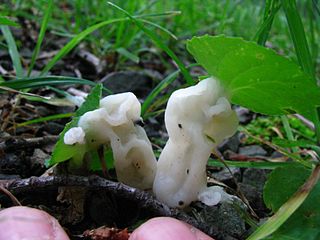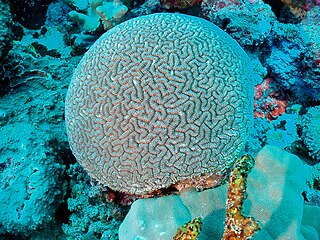
The staghorn coral is a branching, stony coral with cylindrical branches ranging from a few centimetres to over two metres in length and height. It occurs in back reef and fore reef environments from 0 to 30 m depth. The upper limit is defined by wave forces, and the lower limit is controlled by suspended sediments and light availability. Fore reef zones at intermediate depths 5–25 m (16–82 ft) were formerly dominated by extensive single-species stands of staghorn coral until the mid-1980s. This coral exhibits the fastest growth of all known western Atlantic fringe corals, with branches increasing in length by 10–20 cm (3.9–7.9 in) per year. This has been one of the three most important Caribbean corals in terms of its contribution to reef growth and fishery habitat.

Blue coral is a species of colonial coral. It is the only octocoral known to produce a massive skeleton. This skeleton is formed of aragonite, similar to that of scleractinia. Individual polyps live in tubes within the skeleton and are connected by a thin layer of tissue over the outside of the skeleton.

Sebacina is a genus of fungi in the family Sebacinaceae. Its species are mycorrhizal, forming a range of associations with trees, orchids, and other plants. Basidiocarps are produced on soil and litter, sometimes partly encrusting stems of living plants. The fruit bodies are cartilaginous to rubbery-gelatinous and variously effused to coral-shaped. The genus has a cosmopolitan distribution, but fewer than a dozen species are currently recognized worldwide.

The open brain coral is a brightly colored free-living coral species in the family Merulinidae. It is the only species in the monotypic genus Trachyphyllia and can be found throughout the Indo-Pacific.

Acroporidae is a family of small polyped stony corals in the phylum Cnidaria. The name is derived from the Greek "akron" meaning "summit" and refers to the presence of a corallite at the tip of each branch of coral. They are commonly known as staghorn corals and are grown in aquaria by reef hobbyists.

Astreopora is a genus of stony corals in the Acroporidae family. Members of the genus are commonly known as star corals and there are seventeen species currently recognized.

Ctenella is a monotypic genus of stony coral in the family Euphylliidae. It is represented by a single species, Ctenella chagius. These corals are massive in size with meandering valleys between the calyces which have solid, non-porous walls and fine, evenly spaced, solid septae. They are found in the Indian Ocean, Red Sea and Mediterranean Sea. It forms solid, smooth hemispherical domes and is found in the Indian Ocean in the vicinity of the Chagos Archipelago.

Acropora pulchra is a species of colonial staghorn coral in the family Acroporidae. It is found on the back fringes of reefs in shallow water in the western Indo-Pacific Ocean. The oldest fossils of this species date back to the Pleistocene.

Catalaphyllia is a monotypic genus of stony coral in the family Euphylliidae from the western Pacific Ocean. It is represented by a single species, Catalaphyllia jardinei, commonly known as elegance coral. It was first described by William Saville-Kent in 1893 as Pectinia jardinei.
Acropora abrolhosensis is a species of acroporid coral that was first described by John Veron in 1985. Found in sheltered lagoons and shallow reefs, it is listed as a vulnerable species on the IUCN Red List. The population of the species is decreasing, and most specimens are found in Western Australia, but occurs in many other areas. It is also listed under CITES Appendix II.
Acropora awi is a species of acroporid coral that was described by Wallace and Wolstenholme in 1998. Found in fringing reefs, the slopes of shallow reefs, and sandy slopes, it occurs in a marine environment. The species is rated as vulnerable on the IUCN Red List, with a decreasing population, and is easily damaged. It can be found over a large area but is not abundant.
Acropora dendrum is a species of acroporid coral that was first described by Bassett-Smith in 1890. Found in tropical, shallow reefs in areas of powerful waves at depths of 5 to 20 m, it is threatened by disease. The species is rated as vulnerable on the IUCN Red List, with a decreasing population. It is not common but found over a large area, and is listed on CITES Appendix II.
Acropora derawanensis is a species of acroporid coral that was first described by Carden Wallace in 1997. Found in tropical, shallow reefs sheltered from the waves in a marine environment, it is found at depths of 10 to 25 m on reef slopes. The species is rated as vulnerable on the IUCN Red List, with a decreasing population. It is not common but found over a large area, and is listed on CITES Appendix II. It is easily damaged.
Acropora elegans is a species of acroporid coral that was first described by Henri Milne-Edwards in 1860. Found in sheltered, sloping reefs, this species occurs at 30 to 60 m depth. The species is listed as vulnerable on the IUCN Red List, and has a decreasing population. It is not common and has a small range, and is listed under CITES Appendix II. It is more resistant to disease than other Acropora species.
Acropora loisetteae is a species of acroporid coral that was first described by C. C. Wallace in 1994. Found in marine, tropical, shallow reefs in sheltered lagoons, it is found at depths between 1 and 30 m. It is listed as vulnerable on the IUCN Red List, and it is thought to have a decreasing population. It is not common but found over a large area, and is listed under CITES Appendix II.

Astreopora myriophthalma, sometimes known as porous star coral, is a species of hard coral found in shallow water in the tropical Indian and Pacific Oceans. It is a common species with a wide range and the International Union for Conservation of Nature has assessed its conservation status as being of "least concern".

Astreopora gracilis is a species of hard coral found in shallow water in the tropical Indian and Pacific Oceans. It is an uncommon species with a wide range and the International Union for Conservation of Nature has assessed its conservation status as being of "least concern".

Astreopora listeri is a species of hard coral found in shallow water in the tropical Indian and Pacific Oceans. It is an uncommon species with a wide range and is tolerant of turbid water, making it more resilient than some other corals to habitat disturbance. The International Union for Conservation of Nature has assessed its conservation status as being of "least concern".

Heterocyathus is a genus of coral of the family Caryophylliidae.
Astreopora scabra is a species of hard coral found in Eastern Australia, the oceanic west Pacific, Micronesia, Polynesia, Papua New Guinea and American Samoa. It is an uncommon species with a relatively smaller range than many pacific coral species. The International Union for Conservation of Nature has assessed its conservation status as being of "least concern".














